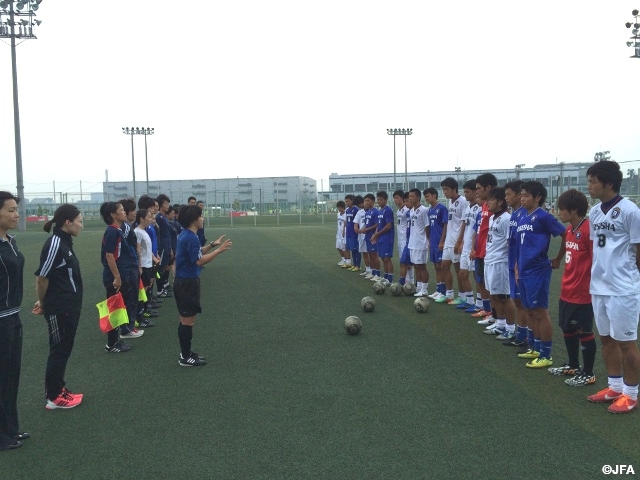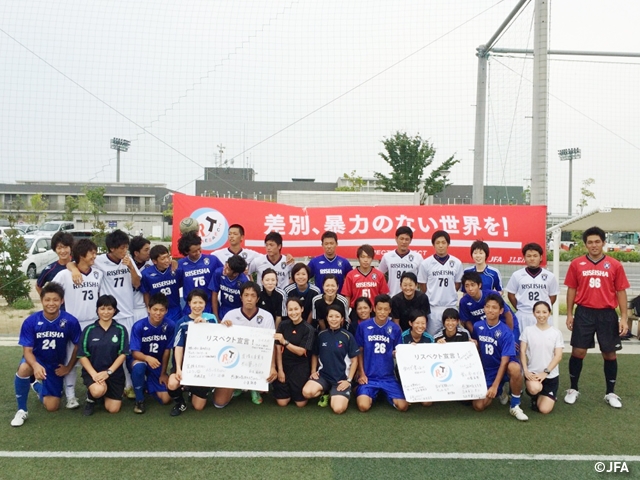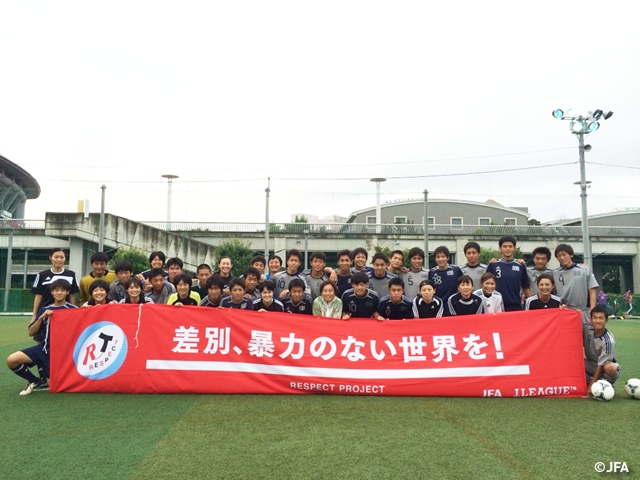NEWS
Training held for female Class 1 referees
16 September 2014

The training session for female Class 1 referees was held for the second time this year. Just as the previous session, the group of participants were divided and the session was held at two different locations, one at J GREEN Sakai on Saturday 6 September and the other at a conference room of Nissan Stadium on Sunday 7, since it is still in the middle of the league season for participating referees.
Instructors Comments
AOKI Takashi, Class 1 Instructor, Okayama
The first half of the training was done in a classroom. We analysed 11 different plays of the actual Nadeshiko League matches in groups, and we had them make a presentation on what went well and what could have done better. Every group discussed various opinions from different perspectives such as from a main referee or from an assistant referee. The discussion was very good, much better than the lecture we teach them one-way. I believe they will take advantage of that discussion in their future work. The rest of the time was a lecture on “judgments around a penalty box” which was part of the practical training in the afternoon. I also showed clips of my own mistakes from my active referee days, and I think I could let them realise the value of learning from mistakes.
In the practical training session, we had them try three key points in making “judgments around a penalty box”. Those were where to position yourself, making eye contacts, and giving clear signals. Before the training we wondered whether the weather would hold, but fortunately we could have the training under a good weather. I think every participant was reminded clearly of those three points by trying both the main referee role and the assistant referee role,
I did the instructor work for female Class 1 referees for the first time, but what impressed me most was Ms Hamazaki’s three-minute speech. She said “My child cheered me up while I was warming up for the match, and those words gave me courage.” I hope many female referees will keep working as “distinguished Nadeshiko referees” even with the heavy workload of as a mother and as a referee.
KISHI Kenji, Class 1 Instructor, Kanagawa
My assignment this time was speaking about “something outside of refereeing”. Of course it had to be something that could educate them and give them positive influence in their referee work and their overall life. So I spoke about a story titled “motivate yourself without thinking like an elephant”. Thinking like an elephant means underestimating yourself. That stops you from motivating yourself. I talked about the importance of believing in yourself, enjoying new challenges, setting goals, planning and executing that plan. I heard the Women’s Committee was going to have all referees set their own goals, so I think my lecture was a little preview of that.
In addition, iin this training the same group of instructors did both Sakai and Shin-Yokohama sessions. This way, the contents and the quality of the training could be the same at two locations, more so than before. I think that was a very good idea. Participating female Class 1 referees at both locations were very enthusiastic, and after watching them work on the field, I saw a very high potential in them. I hope they will take advantage of what they learned in the training and flourish even more in the future.

Participating Referees Comments
MATOZAKI Chikako, Class 1 Referee, Hyogo
We have only limited amount of time in these trainings, but it is always a valuable experience to see referees we don’t see very often and discuss various things with them. In the first part, especially when we watched films of the Nadeshiko League and the Challenge League, I could see “what I would have done if I had been the referee” and “how I could have communicated or confirmed if I had been the assistant referee”. Also we were reminded that even when you are at a close distance, depending on the angle or position, you can’t see and feel what you are supposed to. Then we discussed in groups what we could do about it and we exchanged different views and opinions. It was very informative.
In the practical training part, we again realised what assistant referees can see and can’t see, how assistants can help the main referee, and what kind of help the main referee expects from assistant referees. In the training, you already know the each situation, so it is easier to prepare yourself. But in the actual matches, you always have to aware that “something will happen next moment” and know where you should be to see what is happening. In this training I learned what I should do at important moments in a long 90-minute match. Also I will keep trying in my future work what I learned in the “motivation” lecture, which is not to underestimate myself and “just do it”.
KOIZUMI Asaka , Class 1 Referee, Ibaraki
This training had three parts, lecture, video analysis, and practical training on the field. It was great that we could try what we saw in the video on the field immediately after that. When we talked about the cooperation of main referees and assistant referees, we talked about what one expects from the other and vice versa. We also made sure the different views each referee has. Speaking of the different views, when you position yourself even one meter aside, the position of the ball looks differently. So, to give precise calls, you really have to look at it exactly from the side.
I will use what we learned this time in actual matches I will work on. I will raise my motivation level and work hard to improve myself.


Related News
Latest News
-
National Teams
2024/04/26
【Match Report】U-23 Japan National Team defeat host nation to reach semi-finals of the AFC U23 Asian Cup Qatar 2024™

-
National Teams
2024/04/23
【Match Report】U-23 Japan National Team lose to Korea Republic to advance to knockout stage as runners-up - AFC U23 Asian Cup Qatar 2024™

-
National Teams
2024/04/20
【Match Report】U-23 Japan National Team advance past group stage with two consecutive clean sheets - AFC U23 Asian Cup Qatar 2024™

-
National Teams
2024/04/17
【Match Report】U-23 Japan National Team win first group-stage match despite playing with 10 men following first-half sent-off - AFC U23 Asian Cup Qatar 2024™

-
National Teams
2024/04/12
U-17 Japan Women's National Team squad & schedule - AFC U17 Women's Asian Cup™ Indonesia 2024 (4/27~@Chiba, 4/29~@Thailand, 5/3~@Indonesia)





